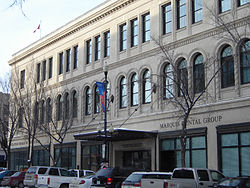| Name of Building | Type | Location | Construction period | Image | Notes |
|---|
| Bank of Toronto branch | Commercial | Guy St. and St. Catherine St. W.), Montreal | 1908 |  | As Ross and MacFarlene. |
| Complexe Les Ailes | Commercial | Montreal | 1925-27 |  | Former Eaton's department store. |
| Saskatoon Board of Education offices | Commercial | Saskatoon | 1928-29 |  | Former Eaton's department store. |
| Former Eaton's Store | Commercial | Calgary | 1928-29 |  | Main structure demolished 1988, partial façade incorporated into Calgary Eaton Centre. |
| Dominion Square Building | Commercial | Montreal | 1928–1930 |  | |
| College Park, Toronto | Commercial | Toronto | 1928-30 |  | Former Eaton's department store - with Sproatt and Rolph. |
| Holt Renfrew Montreal | Commercials | 1300 Sherbrooke Street West, Montreal | 1937 |  | Holt Renfrew closed in 2020, moved with nearby Ogilvy's store on St.Catherine Street. Building converted as residential building called Le Château Apartments. |
| Château Laurier Hotel | Hotel | Ottawa | 1909-12 |  | As Ross and MacFarlene with Bradford Lee Gilbert. [6] |
| Lord Elgin Hotel | Hotel | Ottawa | 1940–41 |  | |
| Royal York Hotel | Hotel | Toronto | 1927-29 |  | With Sproatt and Rolph [7] |
| Fort Garry Hotel | Hotel | Winnipeg | 1910–14 |  | As Ross and MacFarlene. |
| Hotel Saskatchewan | Hotel | Regina | 1926–27 |  | Used beams from the incomplete Chateau Qu'Appelle also designed by Ross and Macdonald. |
| Hotel Macdonald | Hotel | Edmonton | 1912–14 |  | As Ross and MacFarlene. |
| Les Cours Mont-Royal | Hotel | Montreal | 1920-24 |  | (Former Sheraton Mount Royal Hotel, now a shopping mall, condo and office complex) |
| Senate of Canada Building | Public building | Ottawa | 1911-1912 |  | As Ross and MacFarlene designed building, formerly as Ottawa Union Station and later as Government Conference Centre. [8] Now as temporary home of Senate. |
| Union Station | Public building | Toronto | 1914-1920 |  | With Hugh G. Jones, John Lyle [9] |
| Architects' Building | Office building | Montreal | 1929-34 |  | demolished |
| Confederation Building (McGill College Ave. and St. Catherine St. W.) | Office building | Montreal | 1927–28 |  | |
| Castle Building (Stanley Street and St. Catherine St. W.) | Office building | Montreal | 1924–27 |  | |
| Dominion Square Building (Peel Street and St. Catherine St. W.) | Office building | Montreal | 1928–40 |  | |
| Montreal Star Building (St. Jacques St.) | Office building | Montreal | 1926–31 |  | |
| Royal Bank Building (Yonge Street and King Street East) | Office building | Toronto | 1913–15 |  | |
| Édifice Price (Sainte-Anne street) | Office building | Quebec City | 1929–1930 |  | |
| Medical Arts Building | Office building | Montreal | 1922 |  | |
| Le Chateau Apartments, (Sherbrooke and De La Montagne) | Residential | Montreal | 1926 |  | |
| The Gleneagles, (Cote des Neiges Road) | Residential | Montreal | 1929 |  | |
| Central Technical School | High School | Toronto | 1915 |  | |
| The Hydrostone | Commercial | Halifax | 1918 |  | |
| Maple Leaf Gardens | Hockey arena | Toronto | 1931–32 |  | |




























